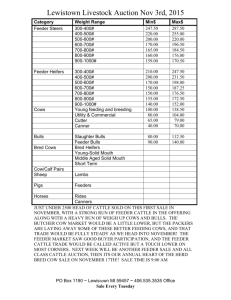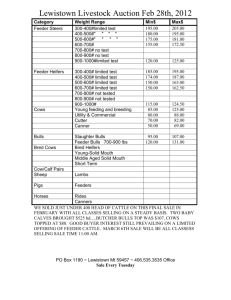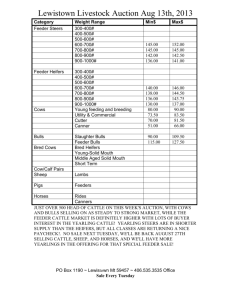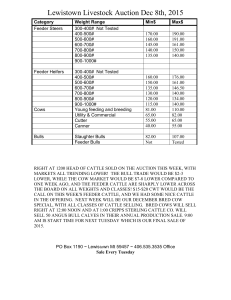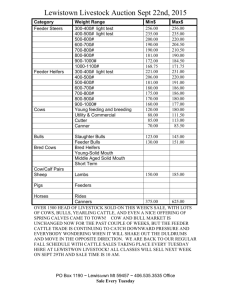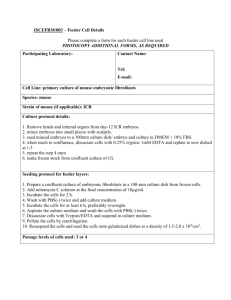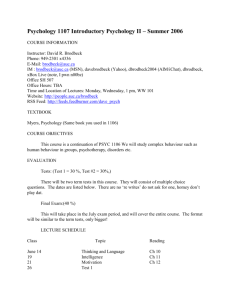Powerpoint slides
advertisement
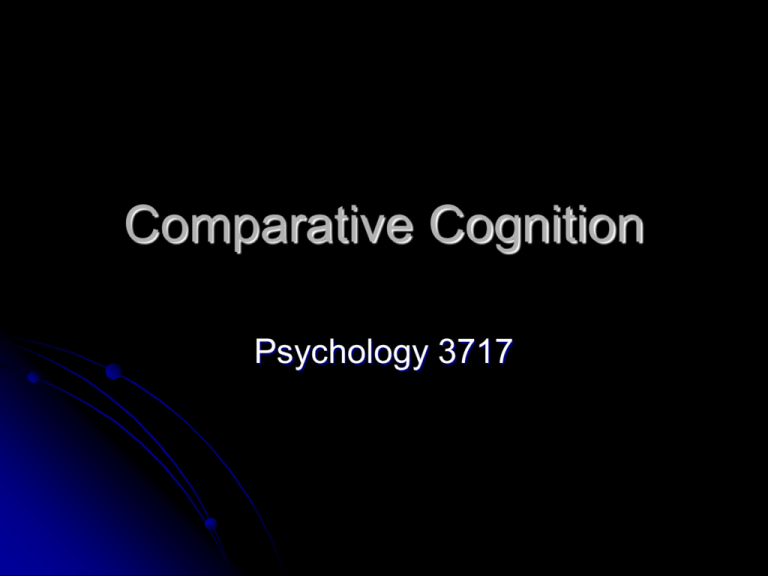
Comparative Cognition Psychology 3717 Introduction Comparative psychology is almost as old as the discipline itself People have wondered what animal is smarter than what other animal for years Many studies have looked for things such as serial position effects, short term and long term memory etc in rats and pigeons There is an implicit question here And that question is…. ‘Can rats do what humans do?’ On the surface this seems an interesting question and indeed almost sensible What is the basis for such a question? Well, we must be at the top of some sort of evolutionary ladder (Campbell and Hodos, 1969) WRONG thanks for playing There is no top, there is no goal These ideas are, simply, wrong! The much better question is ‘what has driven some species to be able to solve a certain type of problem?’ What selective pressures then, have lead to the evolution of certain cognitive mechanisms Asking what species is the smartest is a silly question http://www.exn.ca/Templates/printstory.asp?Pag eName=Animals&story_id=2001050453 So, how do we do comparisons Let’s say we compare two species on some task How do we know that any differences we find in cognitive ability may not be due to differences in motivation? Bitterman’s ideas MacPhail MacPhail basically says that in science we start out with the null hypothesis, that nothing happened, there is no effect In our case, there is no difference between two species But keep that motivational thing in mind, any difference could be motivational Al Kamil’s response There is a bit of a flaw there You set up an hypothesis that you cannot reject! So how do we fix it Al? Test many species on many paradigms OK, I am with you so far Al If we find similar differences in many different tests, it is unlikely that motivation will always be the culprit Error cancels Look at life history, biology, neuroscience and psychology Ask what sort of differences should have evolved Make PREDICTIONS Most awesomest example ever of the synthetic approach Anderson and Krebs, 1978 Mathematical model of when food storing should evolve Food storing can only evolve if you recover your own caches Sherry, Avery and Stevens (1981) Birds seem to recover own seeds using memory More data Shettleworth and Krebs, 1982 Marsh tits storing seeds in a lab Better at recovery of cached seeds than randomly placed seeds Half of seeds removed They are using memory In other general memory tests, there have been clear differences between storers and non storers in the corvid family We have already discussed the hippocampal differences But what about the parids? Data are equivocal Maybe it is not how much they remember, but how they remember Qualitative vs. Quantitative differences Brodbeck and his colleagues…. (ahem) pioneered this type of work Comparing storers and non storers on what they remember in different tasts Brodbeck, 1994; Brodbeck and Shettleworth, 1995 Brodbeck, 1994 Chickadees would find a seed in a feeder Usually return later and eat it Move them around to dissociate colour and spatial location The chickadees responded last to the correctly coloured feeder Non storing Dark Eyed Juncos responded to all three cue types equally And the comparisons continue Same thing on a smaller scale using a computer touch sensitive monitor Birds rewarded for going to one place and not another Different coloured patches Switch them around Chickadees rely on space, juncos do not Indeed, in another experiment it was determined that chickadees when directly tested to very poorly on coulor! Functionally Well functionally this makes a lot of sense Birds remember WHERE something is, not what colour it is Colours change That line of trees over there is still going to be over there However, the strange result really is that of the junco! Brodbeck, Boisvert, Vaughan and Grant (1997) Memory for Space/Colour Compound Stimuli in Pine Siskins David R. Brodbeck1 and Jessica M. Humber2 1- Psychology Department 2- Environmental Science Unit Sir Wilfred Grenfell College Memorial University of Newfoundland Introduction Pine Siskins are finches that breed in Northern North America and conduct the odd invasion into Central and Southern parts of the US and even in to Mexico Their abundance on the West Coast of Newfoundland made them an ideal subject for field study Introduction We decided to test, first of all, if they could be trained to go to different feeders that had different amounts of food Feeders were placed a few metres apart with sunflower seeds in a 3:2:1 ratio Percentatge of Visits Acquisition 60 40 20 0 1 2 3 4 5 6 Blocks of 5 Observation Sessions 7 Seems they can… The birds distributed their feeder visits roughly in a 3:2:1 ratio This of course could be due to the birds actually seeing how much seed was in each feeder Or they could have emptied the rightmost feeder first, the centre one second and the leftmost feeder last….. Well there’s an empirical question if I ever heard one… Well we covered up the feeders and started swapping one feeder with another during test observation sessions So, instead of say ‘green’ ‘red’ ‘yellow’ we would now have, on one test ‘red’ ‘green’ ‘yellow’ Percentage of looks 60 40 20 Percentage of looks Percentage of looks 60 40 20 0 Percentage of looks Percentage of looks 60 40 20 0 Percentage of looks Unbaited Test Sessions 0 Feeder 60 40 20 0 Feeder Feeder 60 40 20 0 Feeder Feeder 60 40 20 0 Feeder So what does it all mean Good question… Seems the siskins respond based on space, sort of They respond based on space if the most profitable feeder is not in the exact opposite position it should be in Once this happens they seem to treat the array as if it is a brand new array they know nothing about Thanks to Animal Memory Working Memory Memory needed to solve one trial of a tast Reference Memory The rules of the game Some cool preparations for studying animal cognition Delayed matching to Sample Delayed Non Matching to Sample Can be qualitative differences here (Mackintosh, Wilson and Boakes, 1982) Both subject to proactive and retroactive interference Symbolic matching and prospective and retrospective encoding Roitblat 1980 Symbolic matching 1) Red sample -> Horizontal line 2) Orange Sample -> Vertical line 3) Blue Sample -> Almost vertical line If they make mistakes when the choices are 1 and 2, they are encoding retrospectively If they do when the choices are 2 and 3, they are encoding prospectively More cool paradigms 8 Arm radial maze (Olton and Samuelson, 1976) We talked about Suzuki et al early on Macuda and Roberts (1997) found that rats actually chunk! Directed forgetting experiments! Inman and Shettleworth (1999) Brodbeck (1997), Brodbeck and Caines (2005) pigeons show priming just like humans
